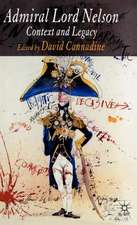Propaganda and Hogarth's Line of Beauty in the First World War
Autor Georgina Williamsen Limba Engleză Hardback – 11 iul 2016
Preț: 385.84 lei
Nou
Puncte Express: 579
Preț estimativ în valută:
73.83€ • 78.95$ • 61.56£
73.83€ • 78.95$ • 61.56£
Carte tipărită la comandă
Livrare economică 17 aprilie-01 mai
Preluare comenzi: 021 569.72.76
Specificații
ISBN-13: 9781137571939
ISBN-10: 1137571934
Pagini: 180
Ilustrații: IX, 176 p. 11 illus., 6 illus. in color.
Dimensiuni: 148 x 210 x 16 mm
Greutate: 0.36 kg
Ediția:1st ed. 2016
Editura: Palgrave Macmillan UK
Colecția Palgrave Macmillan
Locul publicării:London, United Kingdom
ISBN-10: 1137571934
Pagini: 180
Ilustrații: IX, 176 p. 11 illus., 6 illus. in color.
Dimensiuni: 148 x 210 x 16 mm
Greutate: 0.36 kg
Ediția:1st ed. 2016
Editura: Palgrave Macmillan UK
Colecția Palgrave Macmillan
Locul publicării:London, United Kingdom
Cuprins
Introduction.- 1. The Genealogy of the Line and the Role of Resemblances.- 2. The Poster as a Functional Object.- 3. The Static Representation of Movement in Art and War.- 4. Representing the Real in the Aesthetics of Conflict.- 5. Propaganda and the Wider Visual Ecology of the Era.- Conclusion.
Notă biografică
Georgina Williams is a writer andartist. Georgina has exhibited paintings and photography, and is currentlyworking on a continuing photographic project entitled Industrialia.
Textul de pe ultima copertă
Propaganda and Hogarth’s ‘Line of Beauty’ in the First World War assesses the literal and metaphoric connotations of movement in William Hogarth’s eighteenth-century theory of a ‘line of beauty’, and subsequently employs it as a mechanism by which the visual propaganda of this era can be innovatively explored. Hogarth’s belief that this line epitomises not only movement, but movement at its most beautiful, creates conditions of possibility whereby the construct can be elevated from traditional analyses and consequently utilised to examine movement in artworks from both literal and metaphorical perspectives. Propagandist promotion of an alternate reality as a challenge to a current ‘real’ lends itself to these dual viewpoints; the early years of the twentieth century saw growth in the advertising of conflict via the pictorial poster, instigating intentionally or otherwise an aesthetic response from soldier-artists embroiled on the battlefields. The ‘line of beauty’therefore serves as a productive mechanism by which this era of propaganda art can be appraised.












